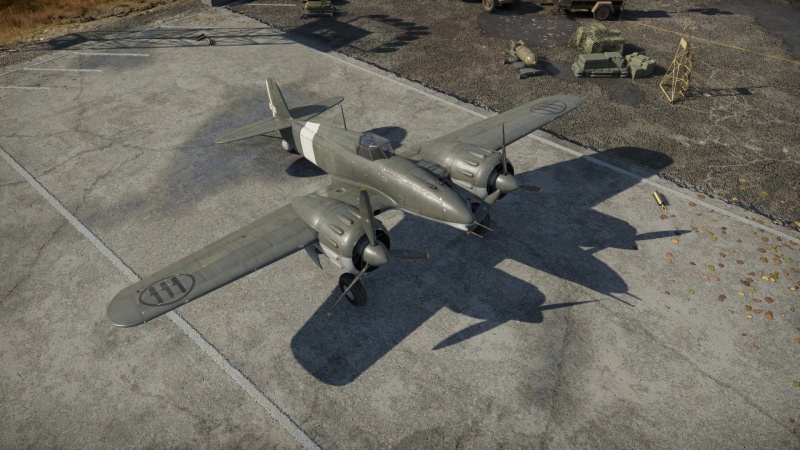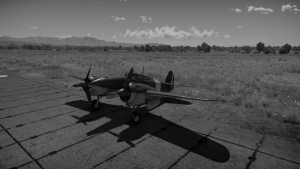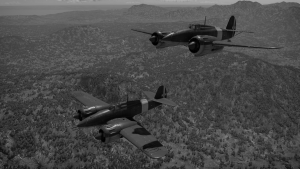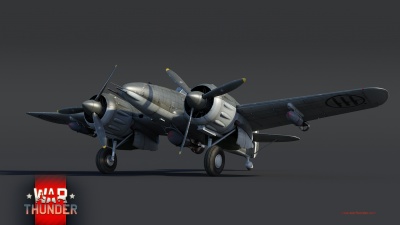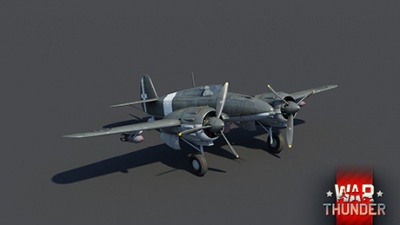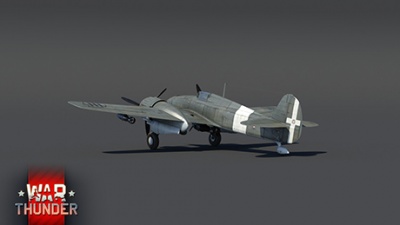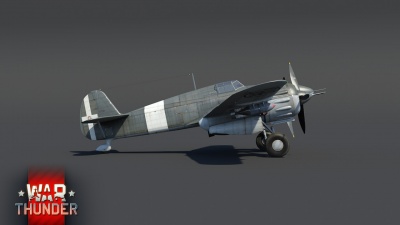Difference between revisions of "Ro.57 Quadriarma"
(→History: done) (Tag: Visual edit) |
(Undo revision 190837 by U144022030 (talk)) |
||
| (5 intermediate revisions by 5 users not shown) | |||
| Line 114: | Line 114: | ||
'''CAS support''' | '''CAS support''' | ||
| − | The | + | The Ro.57 Quadriarma is a champion in Close Air Support at its Battle Rating. With its cannons and payload, it is capable of completely turning around the fortunes of a lost game. The most effective loadout is the 2 x 160 kg bombs and 1 x 250 kg bomb, while as well as the tracer belt for the .50 cal and ground targets belt for the cannons. The launching device of the central bomb is similar to that of the Ju 87 Stuka, so consider having to stay in a dive for about 2 or 3 seconds before the central bomb is released from the mini catapult, in this situation you can extend the airbrake in order to slow down further and be more accurate with the bombs. For the bombs on the wings there are no problems, those are released immediately. |
| − | |||
| − | 2 160 kg bombs and 1 250 kg bomb, while | ||
'''Air Superiority''' | '''Air Superiority''' | ||
| − | In addition to being a good CAS the Quadriarma can play a very important role in air superiority, in this case | + | In addition to being a good CAS, the Quadriarma can play a very important role in air superiority, in this case do not equip bombs, or make sure you have dropped them before you devote yourself to air superiority. In this area it is recommended to arm the Ro.57 with the Tracer or Air Targets belt for the 12.7 mm and the Universal belt for the 20 mm. The Quadriarma strongly suits the energy fighter style of play, even if it doesn't look like it, once enough energy and the right position are acquired, it turns into an excellent fighter. |
=== Manual Engine Control === | === Manual Engine Control === | ||
| Line 164: | Line 162: | ||
== History == | == History == | ||
<!-- ''Describe the history of the creation and combat usage of the aircraft in more detail than in the introduction. If the historical reference turns out to be too long, take it to a separate article, taking a link to the article about the vehicle and adding a block "/History" (example: <nowiki>https://wiki.warthunder.com/(Vehicle-name)/History</nowiki>) and add a link to it here using the <code>main</code> template. Be sure to reference text and sources by using <code><nowiki><ref></ref></nowiki></code>, as well as adding them at the end of the article with <code><nowiki><references /></nowiki></code>. This section may also include the vehicle's dev blog entry (if applicable) and the in-game encyclopedia description (under <code><nowiki>=== In-game description ===</nowiki></code>, also if applicable).'' --> | <!-- ''Describe the history of the creation and combat usage of the aircraft in more detail than in the introduction. If the historical reference turns out to be too long, take it to a separate article, taking a link to the article about the vehicle and adding a block "/History" (example: <nowiki>https://wiki.warthunder.com/(Vehicle-name)/History</nowiki>) and add a link to it here using the <code>main</code> template. Be sure to reference text and sources by using <code><nowiki><ref></ref></nowiki></code>, as well as adding them at the end of the article with <code><nowiki><references /></nowiki></code>. This section may also include the vehicle's dev blog entry (if applicable) and the in-game encyclopedia description (under <code><nowiki>=== In-game description ===</nowiki></code>, also if applicable).'' --> | ||
| − | + | The IMAM Ro.57 was designed and developed by Giovanni Galasso, an aeronautical engineer, and was built by IMAM (Industrie Meccaniche Aeronautiche Meridionali). | |
| − | |||
| − | The first prototype flew in 1939 and the IMAM technicians proposed the Ro.57 to the Regia Aeronautica as a | + | The first prototype flew in 1939 and the IMAM technicians proposed the Ro.57 to the Regia Aeronautica as a dive bomber, but in 1939 the Regia Aeronautica was not interested. |
| − | At the demonstration | + | At the demonstration, the armament was composed by only two 12.7 mm Breda-SAFAT. It had 2 powerful Fiat A.74 R.C.38 engines with 840 HP each and the plane had a maximum speed of 501 km/h at 5,250 metres of altitude. |
| − | After 2 years, during 1941, after the failure of [[Breda 88 (P.XI)|Breda Ba.88]] as an attacker, the Regia Aeronautica decided to return to the Ro.57 project and | + | After 2 years, during 1941, after the failure of [[Breda 88 (P.XI)|Breda Ba.88]] as an attacker, the Regia Aeronautica decided to return to the Ro.57 project and make it a complete attacker. 2 variants were created. |
| − | |||
| − | |||
| − | |||
[[File:Ro.57 Quadriarma during tests.png|thumb|Ro.57 Quadriarma during tests]] | [[File:Ro.57 Quadriarma during tests.png|thumb|Ro.57 Quadriarma during tests]] | ||
| − | In addition to the ventral attachment for a 500 kg bomb, two | + | In addition to the ventral attachment for a 500 kg bomb, two wing pylons were added for bombs up to 250 kg, a ventral window (necessary for targeting), and aerodynamic dive brakes. |
| − | |||
| − | |||
| − | |||
| − | |||
| − | |||
| − | |||
| − | + | The plane got new armament with the addition of two [[Hispano 404 (20 mm)|20 mm Hispano 404]] plus the two [[Breda-SAFAT (12.7 mm)|12.7 mm Breda-SAFAT]] already in the previous tests and prototypes. | |
| − | + | This variant is obscure because the Hispano 404 cannons were only used briefly for testing. | |
| − | When all was said and done, the aircraft was renamed IMAM Ro.57 Bis. The aerodynamic obstruction of the rafters, the ventral window, the aerodynamic brakes and the tailwheel brought the maximum speed down to 480 km/h. Worse still, due to | + | When all was said and done, the aircraft was renamed IMAM Ro.57 Bis. The aerodynamic obstruction of the rafters, the ventral window, the aerodynamic brakes and the tailwheel brought the maximum speed down to 480 km/h. Worse still, due to strange aerodynamic interference, the oil cooler of the right engine provided insufficient cooling, causing a tendency for the engine to overheat at maximum revs, and the aircraft was unstable when diving, thus compromising the accuracy of the dive bombing. |
| − | + | [[File:Ro.57 Quadriarma during training.png|thumb|Ro.57 during training]] | |
| − | [[File:Ro.57 Quadriarma during training.png|thumb|Ro.57 | + | In spite of these defects, the Regia Aeronautica's shortcomings in the field of assault aircraft led, at the end of 1942, to an order for 200 units of the Ro.57 Bis, later reduced to 110. Of these, according to the registration numbers, 75 were built before September 8, 1943, and between 50 and 60 were actually delivered to the Regia Aeronautica (which assigned them to the 97º Gruppo Tuffatori, 226ª and 227ª squadriglia). The aircraft had no importance in the war, as the pilots were not able to finish their training on the new machines before most of the aircraft were destroyed on the ground on July 13, 1943 due to a bombing raid conducted by B-24s on the airfield of Crotone Isola Rizzuto (now Crotone Airport), intended to annihilate the Reggiane Re.2002 of the 5°Stormo and Fiat G.50 of the 50°Stormo that had repeatedly hit the Allied ships engaged in the landing in Sicily. |
| − | In spite of these defects, the Regia Aeronautica's shortcomings in the field of assault aircraft led, at the end of 1942, to an order for 200 units of the Ro.57 Bis, later reduced to 110. Of these, according to the registration numbers, 75 were built before September 8, 1943, and between 50 and 60 were actually delivered to the Regia Aeronautica (which assigned them to | ||
| − | + | The subsequent prototype of the IMAM Ro.58 two-seater heavy fighter was derived from the design of the IMAM Ro.57. | |
=== [[wt:en/news/6998-development-ro-57-quadriarma-en|Devblog]] === | === [[wt:en/news/6998-development-ro-57-quadriarma-en|Devblog]] === | ||
| − | Just before the outbreak of World War II, the Italian Regia Aeronautica placed an order for a heavy fighter for escorting bombers and long air patrols. The IMAM-based design group proposed a twin-engined aircraft with a pair of FIAT A.74RC.38 engines, armed with two heavy machine guns. Soon the aircraft was modified - the armament was reinforced with two | + | Just before the outbreak of World War II, the Italian Regia Aeronautica placed an order for a heavy fighter for escorting bombers and long air patrols. The IMAM-based design group proposed a twin-engined aircraft with a pair of FIAT A.74RC.38 engines, armed with two heavy machine guns. Soon the aircraft was modified - the armament was reinforced with two 20 mm cannons, an air brake was installed, and bomb armament added. |
== Media == | == Media == | ||
| Line 205: | Line 192: | ||
;Skins | ;Skins | ||
| − | * [https://live.warthunder.com/feed/camouflages/? | + | * [https://live.warthunder.com/feed/camouflages/?vehicle=ro_57_quadriarma Skins and camouflages for the {{PAGENAME}} from live.warthunder.com.] |
;Images | ;Images | ||
Latest revision as of 05:01, 11 August 2024
Contents
Description
The Ro.57 Quadriarma is a premium gift rank Italian strike aircraft with a battle rating of (AB), (RB), and (SB). It was introduced during Update "Hot Tracks" as a reward for the 2020 Operation W.I.N.T.E.R. event.
General info
Flight performance
The Ro.57 is quite manoeuvrable for a strike aircraft, with a great roll rate and turn time, and will most likely be able to win turn fights with other twin-engine aircraft. However, remember, the Ro. 57 is not a turn fighter, and should not be used as such. In addition, it's rather slow for its BR, so keep that in mind when chasing enemies.
| Characteristics | Max Speed (km/h at 5,000 m) |
Max altitude (metres) |
Turn time (seconds) |
Rate of climb (metres/second) |
Take-off run (metres) | |||
|---|---|---|---|---|---|---|---|---|
| AB | RB | AB | RB | AB | RB | |||
| Stock | 451 | 436 | 22.9 | 23.9 | 10.2 | 10.0 | 415 | |
| Upgraded | 480 | 466 | 21.2 | 22.0 | 15.0 | 12.5 | ||
Details
| Features | ||||
|---|---|---|---|---|
| Combat flaps | Take-off flaps | Landing flaps | Air brakes | Arrestor gear |
| ✓ | ✓ | ✓ | ✓ | X |
| Limits | ||||||
|---|---|---|---|---|---|---|
| Wings (km/h) | Gear (km/h) | Flaps (km/h) | Max Static G | |||
| Combat | Take-off | Landing | + | - | ||
| 470 | 337 | 280 | ~14 | ~6 | ||
| Optimal velocities (km/h) | |||
|---|---|---|---|
| Ailerons | Rudder | Elevators | Radiator |
| < 380 | < 280 | < 520 | > 250 |
Survivability and armour
- No armour
- Self-sealing fuel tanks (1 in front of the ammunition for armament, 1 behind pilot, 1 in rear fuselage)
Modifications and economy
Armaments
Offensive armament
The Ro.57 Quadriarma is armed with:
- 2 x 20 mm Hispano 404 cannons, nose-mounted (60 rpg = 120 total)
- 2 x 12.7 mm Breda-SAFAT machine guns, nose-mounted (350 rpg = 700 total)
Suspended armament
The Ro.57 Quadriarma can be outfitted with the following ordnance:
- Without load
- 2 x 50 kg GP 50 bombs (100 kg total)
- 2 x 100 kg SAP 100M bombs (200 kg total)
- 2 x 100 kg GP 100T bombs (200 kg total)
- 2 x 160 kg A.P 160 bombs (320 kg total)
- 1 x 250 kg GP 250 bomb + 2 x 100 kg SAP 100M bombs (450 kg total)
- 1 x 250 kg GP 250 bomb + 2 x 100 kg GP 100T bombs (450 kg total)
- 1 x 250 kg GP 250 bomb + 2 x 160 kg A.P 160 bombs (570 kg total)
- 1 x 500 kg GP 500 bomb (500 kg total)
Usage in battles
At the start of the battle, climb as high as you can. Use the air spawn to your advantage. Intercepting bombers is usually your main job as an interceptor. Head-on engagements are an option as you have good frontal armaments located in the nose. If you are engaged by a fighter, don't hesitate to turn fight. Your turn rate with combat flaps is much better than it may appear and is sometimes on par with even the Spitfire's turn rate under the right conditions. Boom and Zoom can be done but do so with extra caution as you will be chased quite easily by enemy fighters.
CAS support
The Ro.57 Quadriarma is a champion in Close Air Support at its Battle Rating. With its cannons and payload, it is capable of completely turning around the fortunes of a lost game. The most effective loadout is the 2 x 160 kg bombs and 1 x 250 kg bomb, while as well as the tracer belt for the .50 cal and ground targets belt for the cannons. The launching device of the central bomb is similar to that of the Ju 87 Stuka, so consider having to stay in a dive for about 2 or 3 seconds before the central bomb is released from the mini catapult, in this situation you can extend the airbrake in order to slow down further and be more accurate with the bombs. For the bombs on the wings there are no problems, those are released immediately.
Air Superiority
In addition to being a good CAS, the Quadriarma can play a very important role in air superiority, in this case do not equip bombs, or make sure you have dropped them before you devote yourself to air superiority. In this area it is recommended to arm the Ro.57 with the Tracer or Air Targets belt for the 12.7 mm and the Universal belt for the 20 mm. The Quadriarma strongly suits the energy fighter style of play, even if it doesn't look like it, once enough energy and the right position are acquired, it turns into an excellent fighter.
Manual Engine Control
| MEC elements | ||||||
|---|---|---|---|---|---|---|
| Mixer | Pitch | Radiator | Supercharger | Turbocharger | ||
| Oil | Water | Type | ||||
| Controllable | Controllable Not auto controlled |
Controllable Auto control available |
Controllable Not auto controlled |
Separate | Not controllable 1 gear |
Not controllable |
Pros and cons
Pros:
- Lethal nose-mounted armament
- Can fly on a single-engine
- Above-average durability
- Decent speed and climb for a twin-engine aircraft of its rank
- Agile for a twin-engine aircraft
- Versatile payloads for many situations
- Relatively short take-off run
- Equipped with airbrakes, allowing for dive-bombing and easy landings
Cons:
- Limited ammunition for the cannons
- Low muzzle velocity on the Breda-SAFAT machine guns
- No armour
- Engine prone to overheating with at high power
- Bomb trapeze creates a delay between pressing the release button and the bomb actually dropping
- Carrying any payload reduces the excellent handling
History
The IMAM Ro.57 was designed and developed by Giovanni Galasso, an aeronautical engineer, and was built by IMAM (Industrie Meccaniche Aeronautiche Meridionali).
The first prototype flew in 1939 and the IMAM technicians proposed the Ro.57 to the Regia Aeronautica as a dive bomber, but in 1939 the Regia Aeronautica was not interested.
At the demonstration, the armament was composed by only two 12.7 mm Breda-SAFAT. It had 2 powerful Fiat A.74 R.C.38 engines with 840 HP each and the plane had a maximum speed of 501 km/h at 5,250 metres of altitude.
After 2 years, during 1941, after the failure of Breda Ba.88 as an attacker, the Regia Aeronautica decided to return to the Ro.57 project and make it a complete attacker. 2 variants were created.
In addition to the ventral attachment for a 500 kg bomb, two wing pylons were added for bombs up to 250 kg, a ventral window (necessary for targeting), and aerodynamic dive brakes.
The plane got new armament with the addition of two 20 mm Hispano 404 plus the two 12.7 mm Breda-SAFAT already in the previous tests and prototypes.
This variant is obscure because the Hispano 404 cannons were only used briefly for testing.
When all was said and done, the aircraft was renamed IMAM Ro.57 Bis. The aerodynamic obstruction of the rafters, the ventral window, the aerodynamic brakes and the tailwheel brought the maximum speed down to 480 km/h. Worse still, due to strange aerodynamic interference, the oil cooler of the right engine provided insufficient cooling, causing a tendency for the engine to overheat at maximum revs, and the aircraft was unstable when diving, thus compromising the accuracy of the dive bombing.
In spite of these defects, the Regia Aeronautica's shortcomings in the field of assault aircraft led, at the end of 1942, to an order for 200 units of the Ro.57 Bis, later reduced to 110. Of these, according to the registration numbers, 75 were built before September 8, 1943, and between 50 and 60 were actually delivered to the Regia Aeronautica (which assigned them to the 97º Gruppo Tuffatori, 226ª and 227ª squadriglia). The aircraft had no importance in the war, as the pilots were not able to finish their training on the new machines before most of the aircraft were destroyed on the ground on July 13, 1943 due to a bombing raid conducted by B-24s on the airfield of Crotone Isola Rizzuto (now Crotone Airport), intended to annihilate the Reggiane Re.2002 of the 5°Stormo and Fiat G.50 of the 50°Stormo that had repeatedly hit the Allied ships engaged in the landing in Sicily.
The subsequent prototype of the IMAM Ro.58 two-seater heavy fighter was derived from the design of the IMAM Ro.57.
Devblog
Just before the outbreak of World War II, the Italian Regia Aeronautica placed an order for a heavy fighter for escorting bombers and long air patrols. The IMAM-based design group proposed a twin-engined aircraft with a pair of FIAT A.74RC.38 engines, armed with two heavy machine guns. Soon the aircraft was modified - the armament was reinforced with two 20 mm cannons, an air brake was installed, and bomb armament added.
Media
- Skins
- Images
- Ro.57 Quadriarma Devblog Images
- Videos
See also
Links to the articles on the War Thunder Wiki that you think will be useful for the reader, for example:
- reference to the series of the aircraft;
- links to approximate analogues of other nations and research trees.
External links
| Southern Mechanical and Aeronautical Industries (IMAM) | |
|---|---|
| Fighters | Ro.57 Quadriarma |
| Floatplanes | Ro.43 · Ro.44 |
| Italy strike aircraft | |
|---|---|
| Ba.65 (K.14) L · Breda 88 (P.XI) · F.C.20 Bis · P.108A serie 2 | |
| Ro.57 Quadriarma · SM.91 · SM.92 | |
| Hungary | ◐Bf 110 G-4 · ◔IL-10 |
| Romania | Hs 129 B-2 (Romania) |
| Italy premium aircraft | |
|---|---|
| Fighters | CR.32 bis · Marcolin's C.R.42 CN · He 112 B-1/U2 · Re.2001 gruppo 22 |
| C. 202D · IAR-81C · ▄Spitfire Mk Vb/trop · ◐Bf 109 F-4 · ◐Bf 109 G-2 · G.55S | |
| Jet fighters | Ariete · G.91 R/4 · ▄F-104S TAF |
| Strike aircraft | ◐Bf 110 G-4 · Hs 129 B-2 (Romania) · Ro.57 Quadriarma |
| AMX A-1A | |



